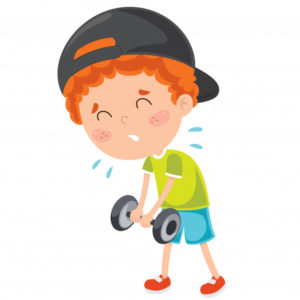CORE MUSCLES
How Important is It? What does it affect?
 In the age of slim, lean, thin being the raw trend, we often miss out on the strength aspect of the bodies. From children to adolescents to adults, prime importance is given to weight loss. Physical fitness, endurance and strength is seldom valued.
In the age of slim, lean, thin being the raw trend, we often miss out on the strength aspect of the bodies. From children to adolescents to adults, prime importance is given to weight loss. Physical fitness, endurance and strength is seldom valued.
Not just the adults but even children have not been left aback from the ill effects of poor muscular strength. Postural instability is no longer the concern of the senior group of population alone.
We have all thought or said this about a child. Or for that matter even the teens around us. So, let us get a little deeper into the concept. When it comes to children, how does core strength matter? Why do we focus more on the trunk stability?
In many cases, toddlers are said to have weak core because of inadequate tummy time during early infancy. At times, we as adults, do not allow the child to explore the environment by picking them up or carrying them every now and then. In children with special needs, both the sensory aspect of development as well as the motor skills get affected. Thus, it is important to understand the correlation between the two as well as know to how to identify these motor difficulties later in life.
To start with, let us understand…
WHAT ARE CORE MUSCLES?
 Core muscles include not just the abdominal muscles but also the muscles of the back, hip and pelvis. Core strength is the development of the torso muscles that stabilize, align the trunk so as to allow free movement of the limbs. Building a stronger core ensures a stronger foundation for your child with respect to better posture, enhanced mobility, qualitative attention span and lesser physical injuries in the later stages of life.
Core muscles include not just the abdominal muscles but also the muscles of the back, hip and pelvis. Core strength is the development of the torso muscles that stabilize, align the trunk so as to allow free movement of the limbs. Building a stronger core ensures a stronger foundation for your child with respect to better posture, enhanced mobility, qualitative attention span and lesser physical injuries in the later stages of life.
HOW WOULD I KNOW IF MY CHILD HAS WEAK CORE MUSCLES?
Here are some signs to identify the risk zones for your child:
- Slumping while standing or sitting on a chair.

- Leaning head on hand, desk or furniture in most of the instances while writing or reading.
- Avoiding gross motor activities (sports, outdoor games)
- Getting fidgety, having difficulty sitting and paying attention.
- Difficulty in fine motor activities (writing)
- Difficulty in rolling, cruising, walking and crawling.
- Difficulty in transitioning from one position to another
- Low on endurance in motor tasks
- Difficulty with bilateral coordination.

WHY IS CORE STRENGTH IMPORTANT?
The main function of the core is to stabilize the trunk while the arms and legs move. This leads to better balance and stability whether on the playing field or in day to day activities. In fact, most of the sports or activities of daily living are dependent on stable core.
The two major functions of the core muscles are:
-
To spare the spine from excessive load.
-
To transfer force from the lower body to the upper body and vice versa.
Having a stronger core prevents a series of muscular, tendinous or even bony injuries.
Sometimes in children with Autism, we see hypotonia, low arousal levels, inefficient muscle coordination, etc. due to inefficient functioning of the core muscles. Parents of children with Autism often complain of the child suffering from constipation and being unable to digest certain foods. These concerns could also be due to inadequate functioning of the core muscles which play a prime role in the same.
Sometimes children who seem to not have motor difficulties are observed to have difficulty sitting comfortably on the floor (cross legged), carrying out writing activities for a long time or putting appropriate pressure on the writing tool. We quite often attribute these concerns to underdeveloped pre-academic skills. Because core is not something that is visible to us… it does not mean they do not exist. Strengthening the core can bring about significant difference in such children.
HOW DO WEAK CORE MUSCLES AFFECT OTHER ASPECTS OF DEVELOPMENT?
Core muscle weakness is not restricted to just the motor development of the individual. As we know and strongly believe that all our body systems are a team and need to work in unison to ensure efficient functioning of each other. So, what possible aspects of development are likely to be obstructed due to a weaker core?
-
SPEECH
Functional speech is the ability to independently communicate meaningful information back and forth with a partner. To develop functional speech, the following building blocks are necessary:
-
Attention
-
Motivation
-
Engagement
-
Imitation
-
Coordination of respiration, phonation and articulation
It takes the right balance of muscles for a child to sit, even for short amounts of time. Core weakness can also contribute to difficulty with the breath support needed for speech production. Chances are if the child has weakness of oral structures (lips, jaws, tongue), it could be due to weak core which provide stability and control for smaller muscles to work effectively.
-
LEARNING
Core stability is important to improve the child’s ability to use their hands for fine motor activities like writing, cutting, painting etc. It also helps to improve the attention span. Any kind of weakness or instability in the core muscles make it difficult for the child to maintain an upright posture and hence they spend a lot of time adapting their body position to compensate for the same, thus impacting their ability to attend to tasks.
If a child has Autism, What do i need to know about core strength?
In a study(1) published by the American Academy of Neurology in 2008, it was found that some kids with autism may have a genetic defect that affects the muscles. The study looked at 37 children with autism spectrum disorders who were evaluated for mitochondrial disease, which causes muscle weakness and prevents a child from being able to participate in physical activities and sports.
Another study(2) done in 2013 examined handgrip strength in participants diagnosed with autism spectrum disorder (ASD) as compared to neurotypical children. The handgrip strength in participants with ASD was found to be significantly lower than the neurotypical controls.
Low muscle tone (also known as hypotonia) is often seen in children with Autism. This in turn gives rise to postural imbalances like slouched posture, drooping shoulders, loss of balance during physical activities, etc. We tend to focus on eye contact, attention span, response to name call, so on and so forth, and tend to ignore the stability of the framework that is needed to hold a person in a balanced position so as to develop focus and cognitive skills.
HOME BASED ACTIVITIES FOR A STRONGER CORE
-
Completing worksheets against the wall.


-
Lying on tummy, propped up on elbows and colouring.
-
Lying on back, propped up on elbows and kicking a ball.
-
Sitting on the therapy ball and swaying.
-
Superman pose.
-
Bridge pose.

-
Wheelbarrow walking.
-
 Animal walks like crab, bear and snake slides.
Animal walks like crab, bear and snake slides. -
Climbing across Monkey Bars.
-
Swimming.
-
Encouraging correct sitting posture.
References:
(1) American Academy of Neurology. (2008, April 15). Kids With Autism May Have Gene That Causes Muscle Weakness. ScienceDaily. Retrieved July 27, 2020 from www.sciencedaily.com/releases/2008/04/080413161104.htm
(2) Kern, J. K., Geier, D. A., Adams, J. B., Troutman, M. R., Davis, G. A., King, P. G., & Geier, M. R. (2013). Handgrip strength in autism spectrum disorder compared with controls. Journal of strength and conditioning research, 27(8), 2277–2281. https://doi.org/10.1519/JSC.0b013e31827de068
(3) Websites:



1 Comment
Vageesh · January 5, 2022 at 1:09 pm
Usefull.information